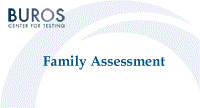Buros-Nebraska Series on Measurement and Testing
Date of this Version
1995
Document Type
Article
Citation
Family Assessment, ed. Jane Close Conoley & Elaine Buterick Werth (Lincoln, NE: Buros Institute of Mental Measurements, University of Nebraska-Lincoln, 1995).
Abstract
INTRODUCTION
Family researchers have been developing measures to assess the quality of the marital relationship for over six decades (e.g., Hamilton, 1929). Indeed, the quality of the husband-wife relationship has been the focus of more research than any other single topic in the field of family study (Spanier & Lewis, 1980). Embedded in these studies are hundreds of varied scales and measures that were designed to assess some aspect of the quality of a marriage (Touliatos, Perlmutter, & Straus, 1990). Lack of consensus on what constitutes marital quality and the absence of any widely accepted and used instruments have contributed to this proliferation of measures. Even scales that enjoy wide use have come under persistent theoretical and methodological criticism (Huston & Robins, 1982; Norton, 1983; Sabatelli, 1988). This state of affairs reflects the different aims of the researchers developing the measures and the evolution over the last several decades of the theoretical and conceptual definitions of the quality of a marriage.
The term "marital quality" has only recently been used to refer to concepts and measures that in the past have been called marital adjustment, satisfaction, and happiness (Spanier & Lewis, 1980). Marital satisfaction and happiness both refer to subjective evaluations of positive affect in the marital relationship by one (or both) of the spouses. Marital adjustment signifies both behavioral and evaluative aspects of a marital relationship. These include dyadic cohesion, satisfaction, consensus, interpersonal tensions, and troublesome dyadic differences (Spanier, 1976). A well-adjusted marriage is often characterized by high interaction and cohesion, low levels of disagreement, high levels of commitment to the relationship (i.e., a low likelihood of leaving the relationship), and good communication and problem-solving abilities. Adjustment is clearly seen as multidimensional, composed of several distinct, but closely related concepts (Spanier & Lewis, 1980). The behavioral and evaluative factors that define marital quality are assumed, based on experience in marital counseling and therapy, to be necessary for a harmonious relationship.
Marital quality measures have been created with two quite different aims: the identification of troubled marriages-primarily a clinical aim, and the desire to test theories related to marital functioning and behavior-a basic research aim. There are no necessary theoretical reasons why measures that function well in one capacity cannot also be valid in the other. Practical and methodological matters, however, often play a more important role. For example, it is unlikely that a 250- item marital assessment scale would be used in a national interview survey of married persons in which the quality of the marital relationship is only one focus. This difference in objectives has been a key factor accounting for variation in concepts and methods used to develop the measures and in the criteria applied to evaluate them. This review focuses on issues of marital quality assessment in nonclinical research settings that use quantitative methods. However, the strong link between family therapy and marital quality research studies-many key researchers are also family therapists-makes it necessary to consider the influence of marital therapy.
Research studies exploring marital quality have, with some notable exceptions, made use of interview or questionnaire data of married respondents collected in one-time (cross-sectional) surveys. This has been the case despite an increasingly awareness that valid answers to some key unsolved issues in the study of marriage over the life course require longitudinal data (Mattessich & Hill, 1987).
It might be expected that reliable and valid measures of marital quality used in cross-sectional studies would be equally applicable to longitudinal samples. Unfortunately, this is not always the case. Many measurement and analysis issues are introduced when inferences are attempted from multiyear samples (Johnson, 1988). Panel analysis raises concerns about the reliability and stability of measures and their ability to reflect changes (Huston & Robins, 1982). The analysis of the dynamics of family development and change requires that the concepts and measures be analytically distinct, particularly when one aspect of the marital relationship is seen as having a causal effect on another (Norton, 1983). A study examining the effect of wife's employment on marital quality could not examine the intervening mechanisms, such as degree of marital interaction or disagreement, which mediate the effect of work on marital happiness or thoughts of divorce (Booth, Johnson, White, & Edwards, 1984) if these are combined in the measure of marital quality.
There have been several reviews of measurement and conceptual issues in assessing the quality of the marital relationship (Sabatelli, 1988; Spanier, 1976; Glenn, 1990; Huston & Robins, 1982; Johnson, White, Edwards, & Booth, 1986; Hicks & Platt, 1970). A recent inventory of marital quality scales is also available (Touliatos, Perlmutter, & Straus,1990). None have focused on the conceptual and measurement issues raised by the increasing amount of life course research that focuses on the dynamics of the marital relationship. The purpose of this chapter is to critically examine a selected set of conceptual and methodological issues that have relevance to the study of marital quality over the life course.
Included in
Educational Assessment, Evaluation, and Research Commons, Family, Life Course, and Society Commons, Quantitative, Qualitative, Comparative, and Historical Methodologies Commons



Comments
Copyright © 1995 by Buros Institute of Mental Measurements. Digital Edition copyright © 2012 Buros Center for Testing.